|
Bill Powelson's,
MUSICAL TIME & RHYTHMS:
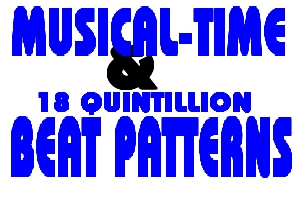
"FINITE TO INFINITY"
Understanding
Time-Signatures and Beat Permutations.
Rhythm Terminology, Symbols and Note Values

NOTE: This info is for those who do not know it already. You'll need all this
to see the big-picture in the later lessons. If you already know all this, just
scan quickly and move on to the next lesson.
What do we mean by note values?
When we speak of note values we are simply talking about slicing a specific (measure) or length of time into smaller portions. It is not very much different from measuring the time of day on any clock. When measuring rhythm though, the length of time being measured is shorter and that length of time may vary. We may count rhythm many various ways and at different speeds.
What is Tempo?
The word 'tempo' is Latin for time, or more accurately in the musical sense, the speed at which we play or feel a piece of music. The drummer must feel the tempo of a song before trying to read or play it.
What do we mean by Beat?
The 'beat' or 'meter' of a song is determined by its count. We count some measures of songs in sections
of fourths with the beat count being a repetitious, one , two, three, four. Other songs may be measured
differently. This count and/or beat flow is determined by the time signature. 4/4 is indicating four fourth-note
counts to the measure, where 6/8 is indicating six eighth-note counts to the measure.
What is a time signature?
The time signature is a formula that determines the counting process for each measure in
a particular musical piece. For example 4/4 is a time signature formula that tells us to count a
piece of music in fours. The top number tells us 'how many' counts and the bottom number tells
us 'what kind' of notes are being counted. In the case of 4/4 the time signature is instructing us
to feel and count four/fourth notes to each following measure.
What do we mean by 'Down Beat'?
The 'down beat' is always the first count in each measure. It's usually the recurring 'boom' sound of the music
and most often falls on a 'one' or 'three' count in 4/4.
What do we mean by 'UpBeat' or 'Backbeat'?
We AREN'T speaking in terms of the 'UP' position of the
conductors wand, here. The 'UPbeat' (in this context) is the 'OFFbeat' or the 'negative' cycling flow
of a beat pattern. It's usually the counts of 2 and 4 in common (4/4) time signatures. To state
it simply, it's usually the repeating, accented 'snap' of the SNARE sounds, within a repetitious
beat pattern.
The Music Staff
We normally write drum notation on a music staff like any other instrument. The music staff usually consists of five lines and four spaces. Each piece of the drumset will occupy a specific line or space on the staff. The writer should always offer a 'code' that explains these designations to the reader.
Sample Staff with Code:
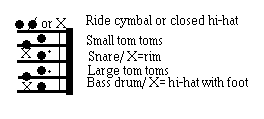
NOTE: Extra lines are sometimes added to the staff when an abundance of percussion/drum parts deem it necessary.
What is a Bar?
In music notation a bar is a vertical line or divider used to mark off the 'measures' to represent equal segments of time.
What is a Measure?
A 'measure' is the space between two bars. It is the segment or slice of time that is to be counted as indicated
by the time signature. We often refer to a 'measure' of music as a 'bar' of music. I'm
showing two full 'bars' or 'measures', in the illustration, below.

NOTE VALUES
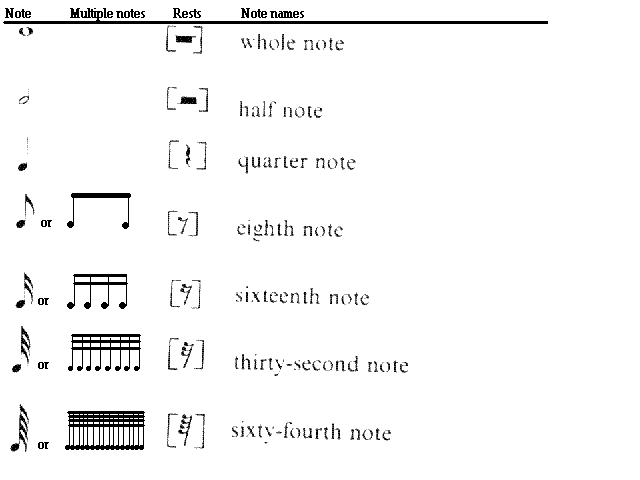
Triplets
A triplet is simply a way of expressing or playing three notes within the time of two. For
example, three half note triplets will occupy the same space and time as two half notes. Three
quarter note triplets will occupy the same time as two quarter notes. A form of triplets will exist
for every note value, from whole notes to sixty-fourth notes and beyond. This will be a little
easier to understand as you study the exercises below. Beginning students may wish to skip whole,
half note and quarter note triplets at first. These triplet forms will make more sense after you
have been playing a while longer.
SPECIAL NOTE: Whole note triplets will be possible in 8/4 time but they will not exist in 4/4.
For the sake of simplicity, I've omitted whole-triplets in the tab below, since
they are so rarely used.
Reading Note Values
The following illustration will help you visualize the way that note values work together to create
a visual picture of common rhythms. The notes on the top line are to be played on the snare (or computer desk)
and the (quarter) notes on the bottom line are to be executed with the right foot or bass drum. The right foot
or bass drum should remain in a steady tempo as you play all the snare notes. When you can play this
entire exercise forward and backward without losing (bass drum) tempo, you will be at genius level. It is
very difficult, so take it in stages. Gain the ability to play the most important part, whole notes through
sixteenths.
R or r = right hand
L or l =left hand.
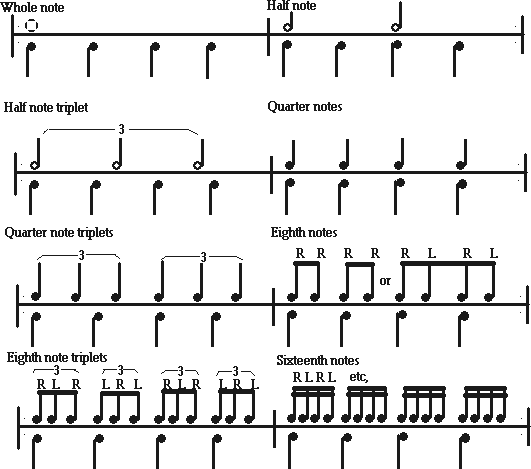
With that accomplished, try playing from sixteenths to sixty-fourths. Next, try working backward from sixty-fourths.
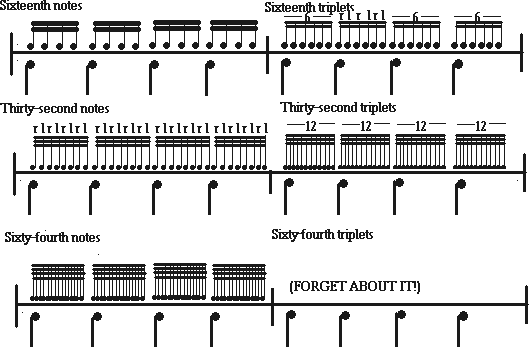
Dotted Notes
A dot beside any note-value or rest will increase the value by half. For example, a dotted half-note will have
the same value as three quarter-notes. A dotted quarter-note will have the same value as three eighth-notes and a
dotted sixteenth will equal three thirty-second notes. Since sustaining or holding a note is difficult with
most percussion instruments, the note should be struck and counted. The actual sound of the note will usually
die-out, long before the count is complete.
Other Musical Expressions and Signs
Crescendo: This is a musical symbol that may be placed over a series of notes, telling the player to increase volume from soft to loud.
Diminuendo: A musical symbol placed over a series of notes, telling the player to begin loud and decrease volume to very soft.

Accents
When the < (accent mark) is placed over an individual note it indicates that the player should play that note louder than the rest.
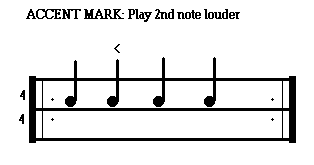
NEXT LESSONS:
Permutations: PERMUTATIONS: Parts I & II.
Be certain you thoroughly understand the PERMUTATION
concept. It's vital towards helping you see the much bigger picture within
the upcoming time-signature lesson. This material is rarely taught in
music theory.
Basic Dance Beat #6: Waltz All the Waltz beats are
considered basic beats too.
This topic has a page of its own. Since Waltzes are 'uneven', they'll also serve as a bridge
towards understanding all uneven time-signatures.

Copyright Bill Powelson
1985-2xxx all rights
reserved.
|








